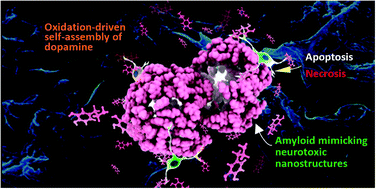Amyloid-mimicking toxic nanofibers generated via self-assembly of dopamine†
Abstract
Molecular self-assembly of biologically relevant aromatic metabolites is known to generate cytotoxic nanostructures and this unique property has opened up new concepts in the molecular mechanisms of metabolite-linked disorders. Because aromaticity is intrinsic to the chemical structure of some important neuromodulators, the question of whether this property can promote their self-assembly into toxic higher order structures is highly relevant to the advancement of both fundamental and applied research. We show here that dopamine, an aromatic neuromodulator of high significance, undergoes self-assembly, under physiological buffer conditions, yielding cytotoxic supramolecular nanostructures. The oxidation of dopamine seems crucial in driving the self-assembly, and substantial inhibition effect was observed in the presence of antioxidants and acidic buffers. Strong H-bonds and π–π interactions between optimally-oriented dopamine molecules were found to stabilize the dopamine nanostructure which displayed characteristic β-structure-patterns with hydrophobic exterior and hydrophilic interior moieties. Furthermore, dopamine nanostructures were found to be highly toxic to human neuroblastoma cells, revealing apoptosis and necrosis-mediated cytotoxicity. Abnormal fluctuation in the dopamine concentration is known to predispose a multitude of neuronal complications, hence, the new findings of this study on oxidation-driven buildup of amyloid-mimicking neurotoxic dopamine assemblies may have direct relevance to the molecular origin of several dopamine related disorders.



 Please wait while we load your content...
Please wait while we load your content...